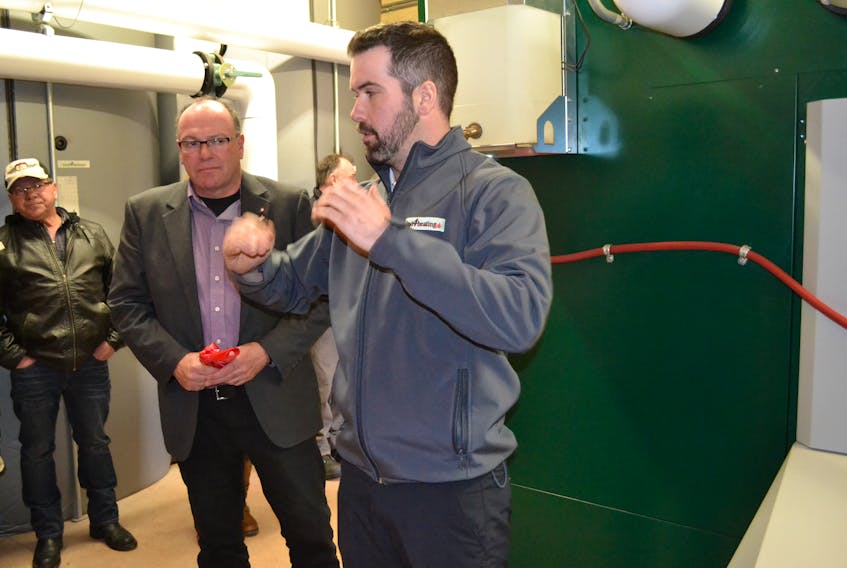TIGNISH
“Tignish is doing its part to slow down climate change,” says Dryden Buote, acting chairman of Tignish Initiatives board of directors.
Buote was speaking during the official opening of Tignish Initiatives district heating project which supplies heat energy to 10 government and commercial buildings in town.
Anne Arsenault, general manager of Tignish Initiatives, said the idea for a district heating project was conceived during a community economic development brainstorming session eight years ago.
The community development organization gradually moved the project idea to the front burner and it gathered steam with a 2015 funding agreement.
Construction of the unit, as well as running pipes to 10 buildings, started last summer and the project was commissioned in January.
“We have a hot water boiler, we feed wood chips. The wood burns and makes heat. We heat the water, we pump the hot water to the buildings, extract the heat returning the warm water to the boilers to be heated and circulated again,” Buote provided a simplified description of the high-tech system.
“It’s not really any different than a hot water heating system in a house. In this case, the rooms are different buildings in Tignish, and we’re using wood chips instead of oil.”
Detlev Elsner, managing director of Wood4Heating which supplied the equipment and technology for the system and will operate it for Tignish Initiatives for the first year, gave a more technical description. It’s a 500-kilowatt system. They monitor all the lines and there is a control unit in each of the buildings which communicate with the boiler house. Three 5,000 insulated tanks or buffers, store the hot water to insure a constant and ready supply of heat.
Replacing oil consumption is a key component of the system explained project manager Bill Drost as, instead of revenues from the purchase of 200,000 litres of oil leaving the province annually, the district heating model will use approximately 500 tonnes of locally sourced wood chips, providing local jobs and leaving the profits in the community.
Elsner acknowledged 500 tonnes of wood chips is a significant amount but he suggested the annual regrowth of wood on P.E.I. would sustain roughly 500 of such systems.
“There is a lot of potential in this.”
Buote reported that over a 20-year period the district heating system is expected to stop approximately 15,000 metric tonnes of greenhouse gases from entering the atmosphere.
The cost of climate change is real, Morrissey insisted. “Unless we change as a society on how we do things, then somebody is going to pay a really big price.”
He commended Tignish Initiatives on moving forward with the project and how it will help reduce Prince Edward Island’s greenhouse gas emissions.”
“This community does a lot of firsts. It’s not afraid to do firsts,” he said suggesting there are few communities in Canada the size of Tignish capable of making such a project happen.
Provincial minister of Transportation, Infrastructure and Energy, Paula Biggar suggested “Not afraid to be first,” would be a good slogan for the community. She said the district heating project is an example of how everyone can work together for environmental best projects.
The federal and provincial governments, through the New Building Canada Fund contributed $752,540 to the project and Tignish Initiatives financed the balance, nearly $400,000, to complete the project.
Drost said the District Heating plant still has capacity to supply more buildings and he indicated there are currently two other businesses showing interest.









